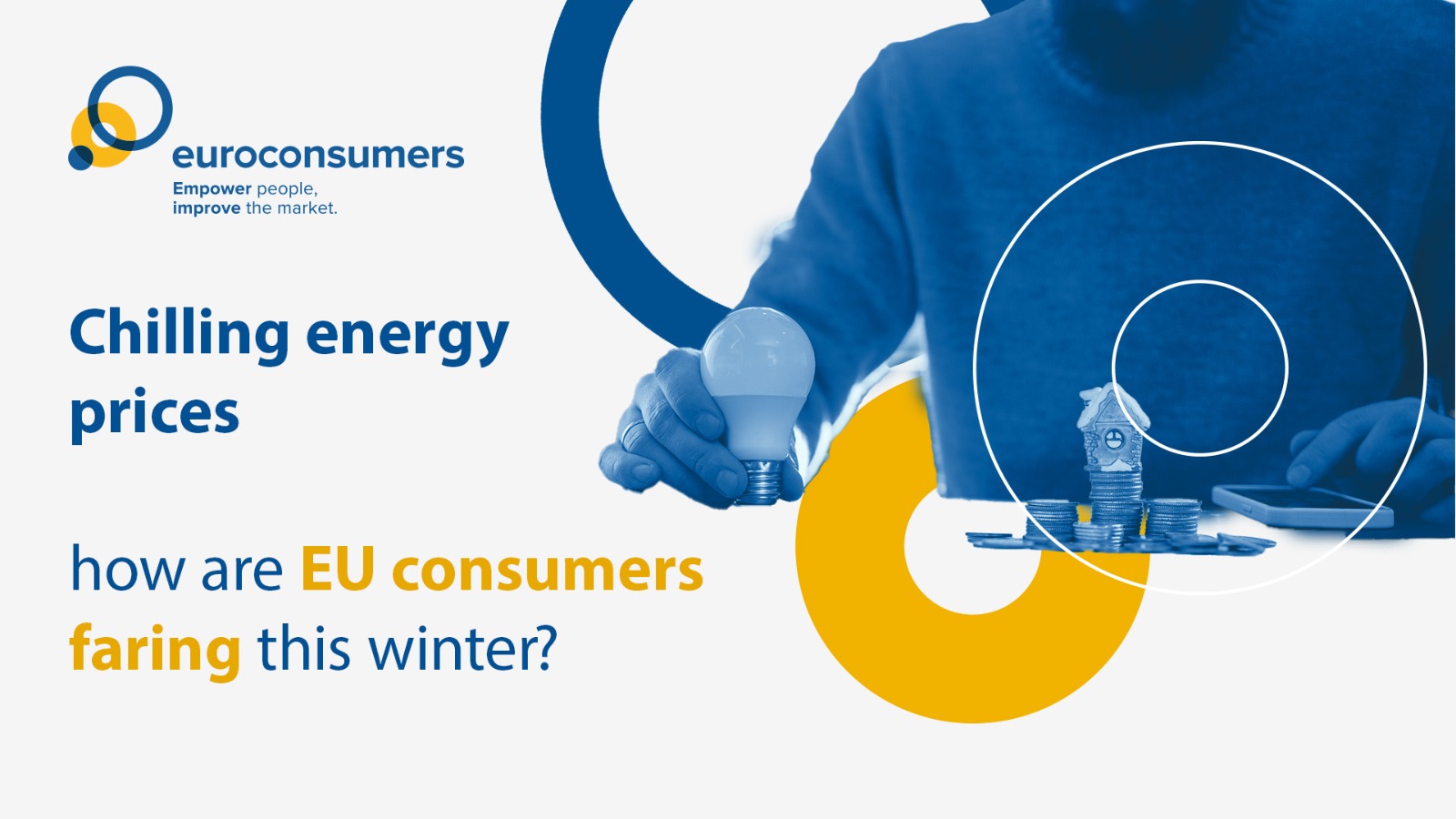
Euroconsumers Forum: charting a path in a world of complexity
Read our take on the speakers, presentations and key learning from the Euroconsumers Forum 2023.
Read More


In the last few years, EU consumers have had to get used to paying a lot for their energy. A mix of factors including the drop in Russian gas imports after the invasion of Ukraine, the restarting of economies after Covid-19 lockdowns and the transition to a different means of energy production have all contributed.
Consumers have felt the pain in their household heating and lighting bills and also in its inflationary effects of high energy prices in products, services and of course transport.
According to Eurostat gas and electricity prices increased in almost all EU countries in the first half of 2023 when compared with 2022. Although wholesale prices have been gradually falling since their peak in late 2022, they still remain higher than before the energy crisis.
This is mostly due to replacing cheaper Russian pipeline gas with more expensive liquified natural gas (LNG). In some countries, the reduction in the wholesale price is reflected in consumers’ contracts, but a vast array of national taxes and tariffs mean different consumers pay very different prices across the continent.
High prices will mean households still might have to make tough choices this winter, but can we expect some relief soon? Unfortunately, the systemic nature of energy markets and the urgent need to transition away from fossil fuel-based production means that higher costs are here for the foreseeable future. This blog looks at the main reasons why and how new legislation from the EU is aiming to alleviate some pressures on consumer budgets.
Let’s not forget the impressive joint European effort to reduce reliance on Russian gas imports which saw a huge 76 percent drop in the first eight months of 2023 (compared with 2022). Such measures are sometimes needed at times of crisis, but the aim should be to restore a healthy, resilient and competitive market as soon as possible.
This winter Europe also increased its security of supply by stockpiling gas supplies and over-reaching the 80% target for gas reserves. Efficiency gains have also been made in terms of consumption – across the bloc, natural gas consumption has dropped by 18 per cent.
One consequence of over three years of high intervention to allay the economic fall out of Covid-19 and to secure reliance on Russia’s gas supply could be a more ready acceptance of state support in key market sectors.
The temptation to continue to subsidize key industries competitive is something some governments might be tempted to if they feel the costs of the energy transition away from gas and fossil fuels put them at a competitive disadvantage.
The energy transition requires an increase in electrification of key sectors like transport and heating which are currently powered by fossil fuels. This relies on a much greater proportion of electricity generation being powered by renewable energies like wind and solar. The goals are hugely ambitious, with new targets for renewables to meet 42.5 percent of final energy demand by 2030 – compared to a 21% share in 2021.In turn, this requires huge investments in maintaining and expanding the electricity grid, the initial investments in renewable energy power plants and the costs of keeping alternative sources like via gas power plants on standby if extra capacity is required.
Some of these costs risk being carried in fees and tariffs on industry and household consumer bills, meaning that renewable energy driven electrification will be a lot cleaner but not necessarily much cheaper for some time yet.
Even if electricity prices drop, the increased demand for electricity due to these net zero targets and energy transition will mean a huge increase in demand – which could push them up.
As we write this, we are anticipating the fall out of the Israel-Gaza conflict which began in October 2023. The action by UK and US forces against Houthis in the Red Sea, a major supply route to Europe, has already begun to impact prices. According to Politico:
“Around 12 percent of the world’s oil and 8 percent of its gas normally flow through the waterway…. Oil prices climbed more than 2.5 percent following the strikes, fueling market concerns of the impact a wider conflict could have on oil supplies from the region.”
Politico, 12 January 2024
Increased sanctions on key oil-producer Iran (an ally of both Hamas and of the Houthis) could see a new energy crisis unfolding with the same type of impacts that consumers have had to endure since 2021. This would push inflation back up again and make the central banks’ job of controlling it much harder.
Against this backdrop the EU has been busy with some major new pieces of legislation which contain significant consumer protection provisions.
Elements of these agreed proposals reflect the experience of price volatility, the hardship of energy poor consumers, the challenge of keeping European energy prices globally competitive and the renewable energy and electrification transition.
The Electricity Directive and Electricity Regulation and the revision of the Gas Directive will be transposed into national legislation by early 2026.
In both gas and electricity markets, vulnerable and disadvantaged consumers will have much stronger safeguards against disconnections and contract terminations. Nationally, member states must all appoint a ‘supplier of last resort’ to make sure that consumers are not adversely affected if a supplier collapses.
Precontractual information is also a priority so that consumers have better insight into what they are signing up for. Research by Euroconsumers’ Belgian member Testachats found that variable priced contracts are complex and hard to understand or even verify, meaning consumers have to just trust the suppliers’ calculation. This leads to confusion and can create mistrust in the energy market – mistrust which could stymie attempts to engage consumers in new services and innovations to help meet net zero targets.
In gas markets, vulnerable and energy poor consumers should be supported if countries decide to remove regulated price controls. Alongside protective measures, the directive wants to make empowered choices much easier with better comparison tools that cover the entire market and have more flexibility to pick and choose between elements of bundled services.
To help with the rising tide of greenwashing, suppliers must back up their claims about low carbon or renewable supplies with clear, verifiable and readily available data.
Many consumers like the certainty of fixed price contracts, but in the past couple of years many have been pulled from the market. This leaves consumers tied to variable price contracts which may put them at risk of exposure to surging prices. The new regulations will ban unilateral changes to fixed price terms and conditions, and do not terminate them before their end date.
Member states will also require that larger suppliers offer both fixed price and dynamic price contracts, to ensure consumer choice. This would align with Euroconsumers’ member organisation, Testachats/Testaankoop’s recent call to bring back a choice of fixed price contracts for those who’d prefer not to weather the risk of fluctuating energy prices.
There are responsibilities too on national energy regulators to assess suppliers’ financial health, in order to anticipate and hopefully avoid bankruptcies. To avoid a crisis situation where wholesale prices surge, the regulation allows for member states to set regulated prices in emergencies.
The electricity rules also specify ways to make peer-to-peer energy sharing easier. Building up usage and trust in renewable solutions and encouraging energy saving is a great way to get consumers engaging in the green transition. Solar panel and heat pump take up is growing in the EU but will take time to become the norm. But other opportunities promised by self-generating household electricity are proving frustratingly difficult to make real.
Take energy sharing for example, something that has been introduced in many European countries including Belgium. Since 2022, regional schemes for energy sharing have allowed consumers to donate or resell solar power that they do not use themselves. Digital smart meters are part of the infrastructure that make this possible:
“Energy sharing is an alternative to selling your surplus production back to the supplier. Households can either choose to share excess electricity for free or can agree a price with the recipient. At the sweet spot where this price is higher than the supplier feed-in tariff, and lower than what the supplier charges the recipient, it could be a win-win for both parties.”
Jordi Van Paemel, Project Officer Energy, Testachats/Test Aankoop
Energy sharing not only makes consumers less dependent on their supplier but ensures that those who cannot afford to invest in solar panels can reap the benefits of the transition to an energy system based on renewable sources. And according to a study from Leuven University, sharing schemes could save average households up to €1,100 per year.
Testachats/Test-Aankoop has found that energy companies are charging consumers who share energy up to €150 in ‘administrative costs’ per year. This sum is likely to wipe out any financial advantage and further erode their trust that energy suppliers are ready to work together with consumers to boost sustainable energy take up. Making it easy for people to engage in the energy transition and have a positive social, economic and environmental impact in their community should be rewarded – not punished with high fees.
The electricity regulation and directive give consumers new rights to share excess electricity from their solar panels through energy sharing schemes, with access to template contract agreements and dispute resolution schemes in case things hit problems.
The new regulations and directives take a broad view of the consumer experience and market design for electricity. From ensuring suppliers are in good financial shape to protecting the most vulnerable and energy poor, and encouraging innovations to drive choice and sustainability.
However, there are larger forces at work which are likely to see consumers’ energy budgets stretched in the medium to long term. As the directives and regulations are transposed into national legislation some practical takeaways have emerged:
Most importantly, after a period of such turmoil, electricity and gas markets must deliver competition, security and transparency with consumers so that they can withstand the ongoing challenges that energy consumers will face.